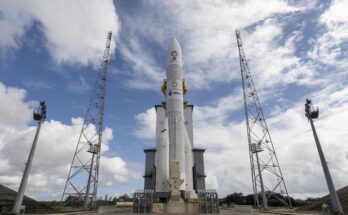by Bill Ostrove, Forecast International.

Human efforts to explore the Red Planet scored several major achievements last month – nitrogen was detected, a rover surpassed the marathon mark in distance traveled and a spacecraft topped six months in orbit. The accomplishments cover three missions, two from the U.S. and one from India.
The U.S. Curiosity rover made the first detection of nitrogen on the surface of Mars when the gas was released during heating of sediments. The nitrogen was detected in the form of nitric oxide, and could be released from the breakdown of nitrates during heating. Nitrates are a class of molecules that contain nitrogen in a form that can be used by living organisms. The discovery adds to evidence that ancient Mars was able to sustain life. While nitrates in this form can be created by living organisms, scientists believe that the molecules found by Curiosity were created by a non-biological process, such as meteorite impacts or lightning.
In another milestone, NASA’s Opportunity rover completed traveling 26.219 miles – the official distance of a marathon run. It took the rover 11 years and two months to cover the distance. The long-lived rover surpassed the marathon mark during a drive of 153 feet (46.5 m). Last year, Opportunity became the long-distance champion of all off-Earth vehicles when it topped the previous record set by the former Soviet Union’s Lunokhod 2 moon rover. Opportunity has made a number of scientific observations during its mission. Currently, it is studying the Endeavour rim, looking for evidence of ancient wet conditions on Mars.
Finally, India’s Mars Orbiter Mission (MOM) topped six months in orbit around the Red Planet. The Indian Space Research Organisation plans to extend the spacecraft’s mission another six months. The actual length of the mission will depend on how well MOM handles a solar eclipse in late April or early May, as a lack of sunlight may affect operations. If fuel is needed to reorient the spacecraft, MOM may see its lifespan shortened.
The milestones demonstrate the importance of Mars to space exploration efforts. Since it is the planet closest to Earth that could potentially support life, it appeals to space agencies and space enthusiasts alike. For that reason, governments will continue to spend money to build robotic exploration systems. Going forward, the U.S. and India will continue to send spacecraft to Mars, with the European Space Agency and other organizations following suit.
A military history enthusiast, Richard began at Forecast International as editor of the World Weapons Weekly newsletter. As the Internet grew in importance as a research tool, he helped design the company's Forecast Intelligence Center and currently coordinates the EMarket Alert newsletters for clients. Richard also manages social media efforts, including two new blogs: Defense & Security Monitor, covering defense systems and international issues, and Flight Plan, which focuses on commercial aviation and space systems. For over 30 years, Richard has authored the Defense & Aerospace Companies, Volume I (North America) and Volume II (International) services. The two books provide detailed data on major aerospace and defense contractors. He also edits the International Contractors service, a database that tracks all the contractors involved in the programs covered in the FI library. More recently he was appointed Manager, Information Services Group (ISG), a new unit that encompasses developing outbound content for both Forecast International and Military Periscope.



